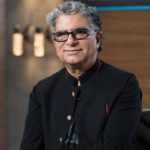“How can you do anything better than be among the first to land and walk on the moon? How can you reach a more magnificent apex in your career than that?” Buzz Aldrin Jr., now 80, is voicing the questions that tortured him for years. For the second man to walk on the moon, the period that followed Apollo 11's lunar landing on July 20, 1969 was anything but magnificent. "I titled my first memoir Return to Earth, because that's exactly what I had to do," he says.
Aldrin's ambition came early. As a young man, he had the drive every parent dreams about. As he puts it, he was "a youth conscious of where he might be going in the future and what it could depend on." (Wow, hear that, kids?) He grew up in a service family, his father a career military man, and became enamored with flight in the ninth grade. He zeroed in on West Point, which would put him in a cockpit faster than his father's recommended path, the Naval Academy. He graduated in 1951 and began pilot training, where most of young Buzz's choices continued to draw fire from the old man.
"By that time, I had the clear joy and adrenaline of air-to-air maneuvering in my training that moved me contrary to what my father suggested, which was I should've gone to the Naval Academy, I should get in to bombers or air defense, and later on, 'Oh no, you really don't want to get into the astronaut program.' "
Yet Aldrin pushed forward on an incredible upward path of achievement. He shot down two Russian MIGs in the Korean War. He received his doctoral degree in aeronautics from MIT. He pioneered theories on how spacecraft could rendezvous in orbit. And then NASA called. Each step was bigger and bolder.
Rapid Ascent
He compares his drive to that of a hungry young actor in Hollywood: “People in show business want to take the biggest part that comes along, whether it has adverse consequences or not. I think anyone in the astronaut corps, given a smidgen of a chance, would want to make the most out of any mission that was assigned to them—and be justified in doing it—even though they might end up in an even more distasteful aftermath.”
Words like aftermath don’t register with us while we’re in pursuit of our dream. We’re too busy achieving. But as we formulate our grand plans—be they business plans, educational goals, or anything that requires dedication and plenty of sweat—we must also develop a second plan: What will I do when I achieve my goal? What comes next? Lay this out as specifically as you do your initial goal, Aldrin says.
He was simply unprepared for life post-Apollo 11. He had assimilated the military academy’s credo of duty, honor and country; he’d learned to appreciate leadership and service; he risked his life in Korea and again in America’s race to the moon. And then, at the lunar crew’s first public appearance in November
1969—to receive an award at Marquette University in Wisconsin—“the anti-establishment students threw eggs at us,” he says.
Aldrin would spend the next decade churning through jobs he didn’t want, two failed marriages, alcoholism and clinical depression. He also admits to some debilitating hero issues. “Growing up in a service family and seeing the meager wages of service and the rewards that come on the inside by doing that, you accept that as being a rock in life. But then if someone says, ‘You’ve been on the moon!’ well… that may change what you think you’re entitled to.”
These failures forced him to recognize that a man can’t walk on the moon forever. And shouldn’t try. At some point, you have to dream beyond what you dreamed before. So he set out to fix things.
Reclaiming Focus
The tool he used most was the same one that any soldier, pilot and astronaut must apply to succeed: trust. If you cannot trust your instincts—as Aldrin’s seemed to fail him during his “return to Earth”—then you must trust everything else: your training, your equipment, the system you’re operating in and the team backing you up. If you can’t trust those things, the static level in your own brain will drown out any attempts to push forward. Aldrin learned this law of trust at West Point.
“The first thing you learn as a plebe, you’re not just one plebe—you’re one of 500,” he says. “And you’re not just one person in a squad—you’re one of two or three plebes in the squad. You’re a part of something, part of great individualism, and yet great teamwork.”
He trusted in his treatment for alcoholism and depression, the professionals helping him and the system of that treatment. He also learned to completely reframe how he viewed his lunar achievements. “I started focusing on an appreciation of the past,” he says. “Knowledge of the past and an optimistic view of the present give you great opportunities if exercised with patience and perseverance. I was able to reclaim the clear focus in my life I’d always had before:
‘Where am I going? What is life leading to?’ Rather than ‘What’s in it for me right now?’ ” he chuckles. “Not many people look beyond ‘What’s in it for me right now?’ ”
Today’s Buzz Aldrin is a different man, and it took him 80 years to get here. And that “Where am I going?” mentality drives him into exciting new projects, for simply asking that question allows you to chart—and change—your course. He wanted business opportunities as well as breakout opportunities, and he found them.
Example: Buzz, along with Michael Jordan and others known for dramatic launches from sea level, now has his own shoe. The first of this year saw the debut of the Nike 6.0 Rocket Hero Mavrk Mid 2, a mouthful of a moniker for slick black high-tops with Buzz Aldrin’s signature on the heel. The insole is printed with a photo of his lunar footprint. The Nike swooshes alternate black and silver to signify the light and dark sides of the moon, and the shoe’s footprint mimics the Apollo moonboots.
Big Dreams
Aldrin also continues to inspire others and teach the lessons he’s learned through public speaking and writing books—such as his recent autobiography Magnificent Desolation, and the children’s book, Look to the Stars.
And, finally, as you have probably heard, Buzz Aldrin was a contestant on Dancing with the Stars. Talk about stepping out of your comfort zone as becoming one of two octogenarians (with Cloris Leachman) to ever compete on the hit show. Buzz reportedly passed a NASA physical to show that he still has world-class fitness.
Amazing? Yes. But here’s the interesting thing about all of these projects: They still, for him, lead back into space, both literally and figuratively. In essence: Why aren’t we challenging ourselves anymore? “I’m quite concerned about our situation right now. I’m not referring to climate change, health care or terrorism. I’m referring to human exploration, the inspiration-inherent challenges I think the human race naturally pushes itself to do. We’re in danger of losing that.”
And that’s the key for Buzz: Do we dream big enough? And when we achieve those dreams, do we dream beyond them to discover not greater greatness, per se, but deeper greatness? The kind that enriches us, that would drive an already great man to fight past his self-destructive tendencies and build on a legend?
Aldrin wants the United States to once again dream big. This astronaut’s driving passion remains the continued exploration of space, which, he says, despite roving Mars and discovering water on the moon, lacks real vision. He wants to raise the stakes: occupy another planet by the year 2035.
Notice he does not say “visit.” He means that humans will stay there permanently. “You don’t want to occupy it and then stop occupying it, because you will have wasted whatever you have invested in occupying it.”
On Top of the World
Any critic could—and would—say that given the current national priorities, Aldrin is dreaming. And Aldrin would shoot back: Dreaming big is exactly the point.
Individuals still dream big, of course, but “big” for them means starting a business, perhaps, or finishing a marathon or simply losing 20 pounds. Aldrin wants to see a society that dares to dream big once again—as this will no doubt bring us together as a people and also lead individuals to push themselves even higher.
And because of Aldrin’s own story, they will then know how to rocket to great heights without the subsequent crash and burn.
“That’s my challenge. It’s doable. Do I think it’s a high probability? Well, not necessarily. But I haven’t given up. In 2019, on the 50th anniversary of the lunar landing, when I’m 89, I’ll certainly be capable of whipping up some support.”
He pauses to let this sink in. “Does this give you an idea of my determination? My motivation? How I look at things right now? And how much more refreshing that is thanhow I was in 1979?”
It took Aldrin years to get here, finally achieving what he calls a life of “consistency and sustainability.” He points to his third marriage, still cooking after 21 years, as an achievement in itself and proof that he’s not the same man he once was. “By some measures of performance in the immediate Los Angeles area, 21 years with the same person is pretty good progress,” he quips.
“I’ve had great results in turning myself into a far more productive, more enlightened, more contributing person than I think I ever was before going to West Point.” Then he chuckles. “If anything, there’ll be a motto on my tombstone: He kept trying.”
In this web exclusive, read Buzz Aldrin's description of walking on the moon.






